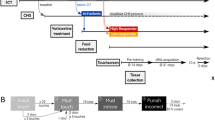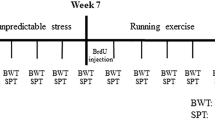Abstract
From clinical studies it is known that recurrent depressive episodes associate with a reduced hippocampal volume. Conversely, preclinical studies have shown that chronic antidepressant treatment increases hippocampal neurogenesis. Consequently, it has been suggested that a deficit in hippocampal neurogenesis is implicated in the pathophysiology of depression. To study a potential correlation between recovery and hippocampal cytogenesis, we established the chronic mild stress (CMS) rat model of depression. When rats are subjected to CMS, several depressive symptoms develop, including the major symptom anhedonia. Rats were exposed to stress for 2 weeks and subsequently to stress in combination with antidepressant treatment for 4 consecutive weeks. The behavioral deficit measured in anhedonic animals is a reduced intake of a sucrose solution. Prior to perfusion animals were injected with bromodeoxyuridine (BrdU), a marker of proliferating cells. Brains were sectioned horizontally and newborn cells positive for BrdU were counted in the dentate gyrus and tracked in a dorsoventral direction.CMS significantly decreased sucrose consumption and cytogenesis in the ventral part of the hippocampal formation. During exposure to the antidepressant escitalopram, given as intraperitoneally dosages of either 5 or 10 mg/kg/day, animals distributed in a bimodal fashion into a group, which recovered (increase in sucrose consumption), and a subgroup, which refracted treatment (no increase in sucrose consumption). Chronic treatment with escitalopram reversed the CMS-induced decrease in cytogenesis in the dentate gyrus of the ventral hippocampal formation, but in recovered animals only. Our data show a correlation between recovery from anhedonia, as measured by cessation of behavioral deficits in the CMS model, and an increase in cytogenesis in the dentate gyrus of the ventral hippocampal formation.
Similar content being viewed by others
Log in or create a free account to read this content
Gain free access to this article, as well as selected content from this journal and more on nature.com
or
References
Alonso R, Griebel G, Pavone G, Stemmelin J, Le Fur G, Soubrie P (2004). Blockade of CRF1 or V-1b receptors reverses stress-induced suppression of neurogenesis in a mouse model of depression. Mol Psychiatr 9: 278–286.
Alves SH, Pinheiro G, Motta V, Landeira-Fernandez J, Cruz APM (2004). Anxiogenic effects in the rat elevated plus-maze of 5-HT2C agonists into ventral but not dorsal hippocampus. Behav Pharmacol 15: 37–43.
Bannerman DM, Rawlins JNP, Mchugh SB, Deacon RMJ, Yee BK, Bast T et al (2004). Regional dissociations within the hippocampus—memory and anxiety. Neurosci Biobehav Rev 28: 273–283.
Bondolfi G, Chautems C, Rochat B, Bertschy G, Baumann P (1996). Non response to citalopram in depressive patients: pharmacokinetic and clinical consequences of a fluvoxamine augmentation. Psychopharmacology 128: 421–425.
Bremner JD, Narayan M, Anderson ER, Staib LH, Miller HL, Charney DS (2000). Hippocampal volume reduction in major depression. Am J Psychiatr 157: 115–117.
Brown ES, Rush AJ, McEwen BS (1999). Hippocampal remodeling and damage by corticosteroids: implications for mood disorders. Neuropsychopharmacology 21: 474–484.
Colombo M, Fernandez T, Nakamura K, Gross CG (1998). Functional differentiation along the anterior-posterior axis of the hippocampus in monkeys. J Neurophysiol 80: 1002–1005.
Czeh B, Michaelis T, Watanabe T, Frahm J, de Biurrun G, van Kampen M et al (2001). Stress-induced changes in cerebral metabolites, hippocampal volume, and cell proliferation are prevented by antidepressant treatment with tianeptine. Proc Natl Acad Sci USA 98: 12796–12801.
Einarson TR (2004). Evidence based review of escitalopram in treating major depressive disorder in primary care. Int Clin Psychopharmacol 19: 305–310.
Fava M, Rankin MA, Wright EC, Alpert JE, Nierenberg AA, Pava J et al (2000). Anxiety disorders in major depression. Comprehensive Psychiatr 41: 97–102.
Fawcett J, Kravitz HM (1983). Anxiety syndromes and their relationship to depressive-illness. J Clin Psychiatr 44: 8–11.
Feng ZD, McCulloch CE (1996). Using bootstrap likelihood ratios in finite mixture models. J R Statist Soc Ser B-Methodological 58: 609–617.
Fuchs E, Czeh B, Flugge G (2004). Examining novel concepts of the pathophysiology of depression in the chronic psychosocial stress paradigm in tree shrews. Behav Pharmacol 15: 315–325.
Gage FH, Thompson RG (1980). Differential distribution of norepinephrine and serotonin along the dorsal–ventral axis of the hippocampal-formation. Brain Res Bull 5: 771–773.
Gilbert M, Racine RJ, Smith GK (1985). Epileptiform burst responses in ventral vs dorsal hippocampal slices. Brain Res 361: 389–391.
Gould E, McEwen BS, Tanapat P, Galea LAM, Fuchs E (1997). Neurogenesis in the dentate gyrus of the adult tree shrew is regulated by psychosocial stress and NMDA receptor activation. J Neurosci 17: 2492–2498.
Gould E, Tanapat P, McEwen BS, Flugge G, Fuchs E (1998). Proliferation of granule cell precursors in the dentate gyrus of adult monkeys is diminished by stress. Proc Nat Acad Sci USA 95: 3168–3171.
Jung MW, Wiener SI, Mcnaughton BL (1994). Comparison of spatial firing characteristics of units in dorsal and ventral hippocampus of the rat. J Neurosci 14: 7347–7356.
Kjelstrup KG, Tuvnes FA, Steffenach HA, Murison R, Moser EI, Moser MB (2002). Reduced fear expression after lesions of the ventral hippocampus. Proc Natl Acad Sci USA 99: 10825–10830.
Lee HJ, Kim JW, Yim SV, Kim MJ, Kim SA, Kim YJ et al (2001). Fluoxetine enhances cell proliferation and prevents apoptosis in dentate gyrus of maternally separated rats. Mol Psychiatr 6: 725–728.
Madsen TM, Treschow A, Bengzon J, Bolwig TG, Lindvall O, Tingstrom A (2000). Increased neurogenesis in a model of electroconvulsive therapy. Biol Psychiatr 47: 1043–1049.
Magarinos AM, McEwen BS, Flugge G, Fuchs E (1996). Chronic psychosocial stress causes apical dendritic atrophy of hippocampal CA3 pyramidal neurons in subordinate tree shrews. J Neurosci 16: 3534–3540.
Malberg JE, Duman RS (2003). Cell proliferation in adult hippocampus is decreased by inescapable stress: reversal by fluoxetine treatment. Neuropsychopharmacology 28: 1562–1571.
Malberg JE, Eisch AJ, Nestler EJ, Duman RS (2000). Chronic antidepressant treatment increases neurogenesis in adult rat hippocampus. J Neurosci 20: 9104–9110.
Malberg JE, Schechter LE (2005). Increasing hippocampal neurogenesis: a novel mechanism for antidepressant drugs. Curr Pharmaceut Des 11: 145–155.
Mchugh SB, Deacon RMJ, Rawlins JNP, Bannerman DM (2004). Amygdala and ventral hippocampus contribute differentially to mechanisms of fear and anxiety. Behav Neurosci 118: 63–78.
McLachlan GJ, Bean RW, Peel D (2002). A mixture model-based approach to the clustering of microarray expression data. Bioinformatics 18: 413–422.
Montgomery SA, Loft H, Sanchez C, Reines EH, Papp M (2001). Escitalopram (S-enantiomer of citalopram): clinical efficacy and onset of action predicted from a rat model. Pharmacol Toxicol 88: 282–286.
Moreau JL, Jenck F, Martin JR, Mortas P, Haefely W (1993). Effects of moclobemide, a new generation reversible mao-A inhibitor, in a novel animal-model of depression. Pharmacopsychiatry 26: 30–33.
Moreau JL, Scherschlicht R, Jenck F, Martin JR (1995). Chronic mild stress-induced anhedonia model of depression; sleep abnormalities and curative effects of electroshock treatment. Behav Pharmacol 6: 682–687.
Moser MB, Moser EI (1998). Functional differentiation in the hippocampus. Hippocampus 8: 608–619.
Muscat R, Kyprianou T, Osman M, Phillips G, Willner P (1991). Sweetness-dependent facilitation of sucrose drinking by raclopride is unrelated to calorie content. Pharmacol Biochem Behav 40: 209–213.
Muscat R, Willner P (1992). Suppression of sucrose drinking by chronic mild unpredictable stress: a methodological analysis. Neurosci Biobehav Rev 16: 507–517.
Papp M, Moryl E, Willner P (1996). Pharmacological validation of the chronic mild stress model of depression. Eur J Pharmacol 296: 129–136.
Papp M, Willner P, Muscat R (1991). An animal model of anhedonia: attenuation of sucrose consumption and place preference conditioning by chronic unpredictable mild stress. Psychopharmacology (Berlin) 104: 255–259.
Paxinos G, Watson C (1986). The Rat Brain in Stereotactic Coordinates. Academic Press: Sydney, Australia.
Sanchez C, Gruca P, Papp M (2003). R-citalopram counteracts the antidepressant-like effect of escitalopram in a rat chronic mild stress model. Behav Pharmacol 14: 465–470.
Santarelli L, Saxe M, Gross C, Surget A, Battaglia F, Dulawa S et al (2003). Requirement of hippocampal neurogenesis for the behavioral effects of antidepressants. Science 301: 805–809.
Schildkraut JJ (1965). The catecholamine hypothesis of affective disorders: a review of supporting evidence. J Neuropsychiatr Clin Neurosci 7: 524–533.
Seri B, Garcia-Verdugo JM, McEwen BS, Alvarez-Buylla A (2001). Astrocytes give rise to new neurons in the adult mammalian hippocampus. J Neurosci 21: 7153–7160.
Sheline YI, Gado MH, Kraemer HC (2003). Untreated depression and hippocampal volume loss. Am J Psychiatr 160: 1516–1518.
Tanapat P, Galea LAM, Gould E (1998). Stress inhibits the proliferation of granule cell precursors in the developing dentate gyrus. Int J Dev Neurosci 16: 235–239.
Vaidya VA, Duman RS (2001). Depression—emerging insights from neurobiology. Br Med Bull 57: 61–79.
van der Hart MGC, Czeh B, de Biurrun G, Michaelis T, Watanabe T, Natt O et al (2002). Substance P receptor antagonist and clomipramine prevent stress-induced alterations in cerebral metabolites, cytogenesis in the dentate gyrus and hippocampal volume. Mol Psychiatr 7: 933–941.
Willner P (1984). The validity of animal models of depression. Psychopharmacology (Berlin) 83: 1–16.
Willner P (1997). Validity, reliability and utility of the chronic mild stress model of depression: a 10-year review and evaluation. Psychopharmacology (Berlin) 134: 319–329.
Willner P (2005). Chronic mild stress (CMS) revisited: consistency and behavioural–neurobiological concordance in the effects of CMS. Neuropsychobiology 52: 90–110.
Willner P, Moreau JL, Nielsen CK, Papp M, Sluzewska A (1996). Decreased hedonic responsiveness following chronic mild stress is not secondary to loss of body weight. Physiol Behav 60: 129–134.
Willner P, Muscat R, Papp M (1992). Chronic mild stress-induced anhedonia: a realistic animal model of depression. Neurosci Biobehav Rev 16: 525–534.
Willner P, Towell A, Sampson D, Sophokleous S, Muscat R (1987). Reduction of sucrose preference by chronic unpredictable mild stress, and its restoration by a tricyclic antidepressant. Psychopharmacology (Berlin) 93: 358–364.
Acknowledgements
We thank JM Kuhn for help with the statistical analysis and J Hellsten, MJ West, C Sanchéz, A Mørk, and R Rosenberg for comments and suggestions. This work was supported by the Danish Research Agency and the Lundbeck Foundation.
Author information
Authors and Affiliations
Corresponding author
Rights and permissions
About this article
Cite this article
Jayatissa, M., Bisgaard, C., Tingström, A. et al. Hippocampal Cytogenesis Correlates to Escitalopram-Mediated Recovery in a Chronic Mild Stress Rat Model of Depression. Neuropsychopharmacol 31, 2395–2404 (2006). https://doi.org/10.1038/sj.npp.1301041
Received:
Revised:
Accepted:
Published:
Issue date:
DOI: https://doi.org/10.1038/sj.npp.1301041
Keywords
This article is cited by
-
Modulation of serotonin transporter expression by escitalopram under inflammation
Communications Biology (2024)
-
Dissecting the role of adult hippocampal neurogenesis towards resilience versus susceptibility to stress-related mood disorders
npj Science of Learning (2022)
-
Chronic mild stress paradigm as a rat model of depression: facts, artifacts, and future perspectives
Psychopharmacology (2022)
-
Vortioxetine ameliorates anhedonic-like behaviour and promotes strategic cognitive performance in a rodent touchscreen task
Scientific Reports (2021)
-
Adult-born neurons from the dorsal, intermediate, and ventral regions of the longitudinal axis of the hippocampus exhibit differential sensitivity to glucocorticoids
Molecular Psychiatry (2021)



